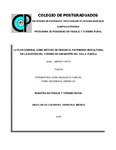| dc.contributor.author | Jiménez Ortíz, Anali | |
| dc.creator | JIMÉNEZ ORTÍZ, ANALI; 886929 | |
| dc.date.accessioned | 2021-03-16T19:35:02Z | |
| dc.date.available | 2021-03-16T19:35:02Z | |
| dc.date.issued | 2019-12 | |
| dc.identifier.uri | http://hdl.handle.net/10521/4443 | |
| dc.description | Tesina (Maestría en Paisaje y Turismo Rural).- Colegio de Postgraduados, Campus Córdoba, 2019. | es_MX |
| dc.description.abstract | La investigación presenta una metodología para realizar un diagnostico del Patrimonio Biocultural en un grupo social, básado en la teoría de La Flor Comunal de José Rendón; la herramienta de trabajo es diseñada en la fusión de la teoría de La Flor Comunal y la Guía práctica para capacitadores del Fondo Mundial para la Naturaleza (WWF por sus siglas en inglés). Se seleccionó la comunidad de San Martín del Valle, Zapotitlán, Puebla; dado que presentó elementos de la Comunalidad, la población en cuestión desempeña actividades de turismo de naturaleza dentro de su territorio bajo la gestión de un comité comunitario. La aplicación de la herramienta diseñada se realizó con un grupo de la población, teniendo como resultado el estado actual del Patrimonio Biocultural de San Martín del Valle, y la autoreflexión de los participantes para tomar acciones para conservar su Patrimonio Biocultural. _______________ THE COMMUNAL FLOWER AS A METHOD OF THINKING ABOUT BIOCULTURAL HERITAGE IN TOURISM MANAGEMENT IN SAN MARTIN DEL VALLE, PUEBLA. ABSTRACT: The research presents a methodology to make a diagnosis of the Biocultural Heritage in a social group, based on the theory of José Rendón's La Flor Comunal; The work tool is designed in the fusion of the Communal Flower theory and the Practical Guide for trainers of the World Wide Fund for Nature (WWF). The community of San Martín del Valle, Zapotitlán, Puebla was selected; Given that it presented elements of the Community, the population in question performs nature tourism activities within its territory under the management of a community committee. The application of the designed tool was carried out with a group of the population, resulting in the current state of the Biocultural Heritage of San Martín del Valle, and the participants' self-reflection to take actions to conserve their Biocultural Heritage. | es_MX |
| dc.description.sponsorship | Consejo Nacional de Ciencia y Tecnología (CONACyT). | es_MX |
| dc.format | pdf | es_MX |
| dc.language.iso | spa | es_MX |
| dc.rights.uri | http://creativecommons.org/licenses/by-nc/4.0 | es_MX |
| dc.subject | Flor Comunal | es_MX |
| dc.subject | Patrimonio Biocultural | es_MX |
| dc.subject | San Martín del Valle | es_MX |
| dc.subject | Communal Flower | es_MX |
| dc.subject | Biocultural Heritage | es_MX |
| dc.subject | Paisaje y Turismo Rural | es_MX |
| dc.subject | Maestría | es_MX |
| dc.subject.classification | CIENCIAS SOCIALES::DEMOGRAFÍA::DEMOGRAFÍA GEOGRÁFICA::DEMOGRAFÍA RURAL | es_MX |
| dc.title | La flor comunal como método de pensar el patrimonio biocultural en la gestión del turismo en San Martín del Valle, Puebla. | es_MX |
| dc.type | Tesis | es_MX |
| Tesis.contributor.advisor | Muñoz-Márquez Trujillo, Rafael Arturo | |
| Tesis.contributor.advisor | Hidalgo Contreras, Juan Valente | |
| Tesis.contributor.advisor | Nahmad Molinari, Daniel | |
| Tesis.date.submitted | 2019-12 | |
| Tesis.date.accesioned | 2021 | |
| Tesis.date.available | 2021 | |
| Tesis.format.mimetype | pdf | es_MX |
| Tesis.format.extent | 4,194 KB | es_MX |
| Tesis.subject.nal | Turismo rural | es_MX |
| Tesis.subject.nal | Rural tourism | es_MX |
| Tesis.subject.nal | San Martín del Valle,municipio de Zapotitlán, Puebla, México | es_MX |
| Tesis.rights | Acceso abierto | es_MX |
| Articulos.subject.classification | Turismo | es_MX |
| dc.type.conacyt | masterThesis | es_MX |
| dc.identificator | 5||52||5203||520305 | es_MX |
| dc.contributor.director | MUÑOZ MÁRQUEZ TRUJILLO, RAFAEL ARTURO; 202480 | |
| dc.audience | generalPublic | es_MX |


